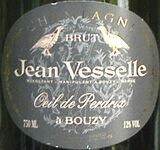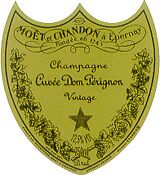|
In This Issue • Overview: Champagne and value • Jean Vesselle Champagne Brut "Oeil de Perdrix" ($30.99) • Moët et Chandon 1996 Champagne Dom Perignon Brut (€94 at the winery; $100 to $160 at U.S. vendors) • Matching Champagne with food • Cellaring and drinkability • Why it justifies the price • Web links • Where to find these wines • Administrivia • Next regular issue: Tuesday, June 15, 2004 |
Back in the Gay Nineties (the 1890s, that is), the legendary "Diamond Jim" Brady would famously quaff three quarts of Mumm Cordon Rouge Champagne with his 12-course dinner. In the Roaring Twenties, legend has it, baseball luminary George Herman "Babe" Ruth would occasionally wash down a dozen hot dogs with a bottle of bubbly.
Now the 21st century is here and hip-hop stars can't get enough of the stuff, or so says The Observer in London, which recently reported, "The American rap bands insist on Cristal but they only drink it through a straw. Puff Daddy and his group will walk around backstage drinking Cristal, and then they'll leave half-empty bottles strewn around the place."
It has been three centuries since the original Dom Pierre Perignon, the wine-making French monk, perfected the bubbly beverage. And if he didn't actually invent the stuff, nor exclaim "I'm drinking stars!" as legend suggests, he certainly helped make it commercially feasible. Almost since the beginning, from the courts of Louis XIV and the emperor Napoleon to Diamond Jim, the Babe and, well, Puff Daddy, Champagne has stood as the symbol of conspicuous consumption, a sought-after product with a price driven out of all reasonable relationship to its actual worth by a thirsty demand that outstrips the supply.
It's no coincidence that all three of the historic Champagne houses that I visited during a tour of the region last week - Ruinart, Veuve Cliquot Ponsardin and the makers of Dom Perignon, Moët et Chandon - are all now under the ownership umbrella of Louis Vuitton Moët Hennessey (LVMH), one of the world's leading producers of luxury goods.
With some 250 years of experience under each of their corporate belts, these producers in Reims and Epernay in France's Champagne region indisputably make fine wines. Their top-of-the-line vintage Champagnes rank among the world's best wines, whether red, white or pink, sparkling or still.
But for wine lovers who seek a high proportion of value to quality in their purchasing, Vintage Champagne simply isn't competitive. Each major house's high-end "Tete de Cuvée" ("head of the blend") sells merrily, But at prices four or five times the tag on the same producer's non-vintage blends, and typically triple the hand-crafted wines of smaller artisanal producers who boast an intense commitment to quality but lack the demand, the canny buyer's choice is clear: Steer clear of the sought-after labels in favor of the less-beaten path.
If the price is right, I'm almost tempted to buy at random from artisanal producers when I find them in the $25 to $30 range, particularly if the wine is distributed by a trustworthy importer. Terry Theise (who is better known for his German wines but also represents a group of small Champagne producers) is an almost unerring guide. I've also enjoyed good Champagnes from little-known labels brought in by Kermit Lynch and North Berkeley Imports in California and Vintner Select in Cincinnati.
Another usually reliable approach is to grab your magnifying glass and check the name of the Champagne village (if any is shown) on the wine label. Just 17 of the 313 wine-producing villages in Champagne are entitled to the designation "Grand Cru," and wines from these villages - Ambonnay, Avize, Ay, Beaumont sur Vesle, Bouzy, Chouilly, Cramant, Le Mesnil-sur-Oger, Louvois, Mailly Champagne, Oger, Oiry, Puisieuix, Sillery, Tours-sur-Marne, Verzenay and Verzy - boast a viticultural heritage that's hard to beat. Finally, depending on your style preferences, look for Champagnes containing plenty of Pinot Noir, if you prefer fuller-bodied, aromatic Champagnes as I do; or go for the all-Chardonnay blends (often labeled "Blanc de Blancs") if you prefer your Champagne steely but light.
I had occasion to taste the just-released 1996 Dom Perignon at Moët et Chandon last week, and it was an impressive experience to be sure, if simply because sitting in the sunny gardens at Moët's imposing 18th Century granite buildings in Epernay is an experience in itself. The American critic Robert M. Parker Jr. reportedly gave the '96 Dom a gushing review and 98-point rating, according to a summary posted in the winery gift shop, where the wine is on sale for €94. The British critic Jancis Robinson was more reserved in her praise, as for that matter was Moët's own sommelier, Henri Glowacki, who poured the wine and was refreshingly, almost startlingly, candid about it: "'96 is not the best vintage." Parker to the contrary notwithstanding. I'm with them. It's a nice wine, balanced and elegant. But for one-third the price, give me a rich, complex artisanal wine at one-third the price, like the Jean Vesselle "Oeil de Perdrix" featured below.
 Jean Vesselle Champagne Brut "Oeil de Perdrix" ($30.99)
Jean Vesselle Champagne Brut "Oeil de Perdrix" ($30.99)
This fine Pinot Noir-based Champagne from the grand cru village of Bouzy shows a brilliant pale-bronze color in the glass; not as pink or as deeply hued as a rosé, this is the "Oeil de Perdrix" ("partridge eye") of the wine's proprietary name. It bubbles up with a frothy mousse when poured, then falls back to an active, extremely persistent stream of pinpoint bubbles that lasted for more than 90 minutes in a glass set aside untouched to see just how long it would go on. Lovely Pinot Noir-Champagne scents of yeasty brioche and crisp apples rise from the glass, backed by a pleasant whiff of cocoa that I often notice in Pinot-based bubblies. Mouth-filling and creamy, frothy on first taste, then full-bodied and appropriately acidic, crisp apples and juicy lemons are blended in a sweet-tart citric tang that lasts and lasts. U.S. importer: Vintner Select in Cincinnati, and other regional importers. (June 2, 2004)
 Moët et Chandon 1996 Champagne Dom Perignon Brut (€94 at the winery; $100 to $160 at U.S. vendors)
Moët et Chandon 1996 Champagne Dom Perignon Brut (€94 at the winery; $100 to $160 at U.S. vendors)
Pale gold in color, with abundant, lasting streams of bubbles. A bit of sulfury funk on first pouring - probably the result of recent bottling - blows off quickly to reveal clean apple scents. Creamy, fresh and crisp on the palate, balanced and elegant if not overly complex. It's certainly drinkable now, but Dom Perignon, like most high-end vintage Champagnes, will reward the patient collector with increasing richness and complexity after several years of careful cellaring. Tasted at the winery. The U.S. importer is Schieffelin & Somerset Co., NYC, a subsidiary of LVMH. (May 29, 2004)
Matching Champagne with food
Champagne lovers boast that quality sparkling wine goes with everything, and it's certainly true that its quenching carbonation makes it at least drinkable with a wide range of foods. I'm not really persuaded by Champagne with robust red meat, though, or sweet desserts.
When it's served as an aperitif, Champagne goes well with a variety of snacks and finger foods. Caviar is traditional, most likely because it's another form of conspicuous overconsumption, although in fairness, its salty-fishy flavor works well with Champagne's steely acidity, and its tiny, bursting-with-flavor grains seem to mesh nicely with the bubbles in the wine. Smoked salmon is a great match, especially with rosé or blanc de noirs Champagnes, and just about any shellfish works very well.
At the table, I usually treat Champagne as a rich, hearty white wine, and think of it with fish and seafood dishes, chicken or veal, an approach that was consistently borne out at fine restaurants during our recent trip through Champagne. Fish dishes with Champagne-and-cream reduction sauces meshed perfectly with the wine, as did simple preparations involving shellfish, particularly crayfish. A butter-tender piece of veal was served with a blanc de noirs; but with one memorable piece of Charolais beef with a deep, dark red-wine reduction sauce, the sommelier recommended ... a Burgundy!
With the Jean Vesselle wine rated above, I thought about shrimp or veal but ended up with a simple dish of crab cakes, as featured in this week's edition of the Wine Advisor FoodLetter.
Cellaring and drinkability
Champagne is made to drink as soon as it is released to the marketplace, and it really requires no cellaring. That being said, however, the better Champagnes - particularly the high-end vintage models - can benefit with careful cellaring, evolving into an almost ethereal richness and complexity, although the tradeoff may be some loss of carbonation over extended time.
Don't even consider it unless you have excellent cellar conditions with a constant cool temperature, however; and even then, be aware that lighter-style non-vintage Champagnes, and most non-Champagne bubblies, won't benefit from aging at all and are probably best drunk up within a year or two after purchase.
Why it justifies the price
As discussed above, to be blunt, few of the high-end Champagnes do justify their price, which is inflated beyond reality by demand that significantly exceeds the supply. While a few of the very high quality Champagnes that for one reason or another have not become mass-market icons - Champagne Krug, for example, and Pol Roger's Winston Churchill Cuvee - remain relative bargains, my advice is to forget the super-premium bubblies entirely and pass by the non-vintage bubblies from the larger houses, taking advantage instead of the artisanal wines from quality, less-known producers that still offer real value for their price.
Web links
Jean Vesselle has a Website in both French and English. The English-language pages begin here:
http://www.champagnejeanvesselle.fr/som_e.html
It's not easy to find corporate information about Dom Perignon online. Moët et Chandon's Website is at
http://www.moet.com/
but because LVMH treats Dom Perignon as a separate brand, the Moët site doesn't address it. You can find a promotional page about Dom Perignon on the LVMH English-language site,
http://www.lvmh.com/
but you have to work down through "Site Map," "Wines & Spirits" and "Dom Perignon" to get there.
Where to find these wines
Distribution of artisanal wines like Jean Vesselle is spotty. It's best to check with quality local wine shops or search the Internet. Wine-Searcher's database may help,
http://www.wine-searcher.com/find/Vesselle/NV/-/USD/A?referring_site=WLP
As the top product of one of Champagne's major houses, 1996 Dom Perignon will be available worldwide to those who want it. Check local wine shops or look for vendors on Wine-Searcher.com,
http://www.wine-searcher.com/find/Dom+Perignon/1996/-/USD/A?referring_site=WLP
The Liquor Control Board of Ontario's Vintages program lists Dom Perignon for CDN$179.95 but does not indicate what vintage is available. It's LCBO Item No. 280461,
http://www.vintages.com/frame_results.html?ITEM_NAME=dom+perignon
The SAQ in Quebec offers the 1996 for CDN$181, Code de Produit 00280461. To find it, search "Dom Perignon" from the home page,
http://www.saq.com
Many vendors in Australia offer 1996 Dom Perignon in the range of AUD$200 to $250. The Australian Wine Centre, an Internet merchant in Adelaide, lists it for AUD$199,
http://www.auswine.com.au.
Prices vary rather dramatically in the UK, where Berry Bros & Rudd offers the 1996 for £68. See the firm's Website,
http://www.bbr.com/gb.lml.
Archives
Premium Edition archives will be available only to subscribers.
Back
|
The "Subscribe now" button below will take you to our Shopping Cart on a fully secure server, where you can use your MasterCard, Visa, American Express or Discover card with confidence to pay the $24 annual subscription fee. However, if you would rather pay by check, please feel free to contact me for information by E-mail at wine@wineloverspage.com. Within 24 hours after we have received your payment, we'll send a reply with instructions to complete your registration, and you will begin receiving the 30 Second Wine Advisor Premium Edition on the next date of publication. |
